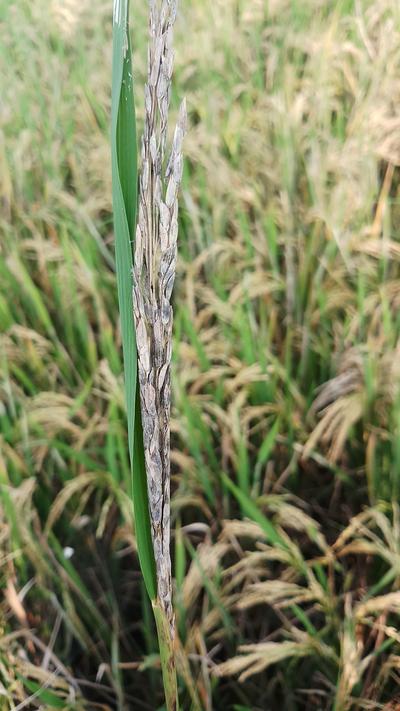Udbatta Disease of Rice
Balansia oryzae-sativae
Fungus
In a Nutshell
- Panicle deformation - single, straight, dirty cylindrical rod.
- Upper leaves and sheath leaves covered with white fungus, appears silvery.
- Stunted growth.
Can also be found in
Symptoms
Symptoms first become evident at the time of panicle emergence. Infection is systemic and all tillers are involved. Infected plants are usually stunted and characterized by a white mycelial mat that ties panicle branches together. Panicles emerge as single, straight, dirty-coloured, cylindrical rods out of the sheath. Upper leaves and sheath leaves can also be distorted and appear silvery. The white mycelium form narrow stripes along the veins. No grains are formed on the affected ear.
Recommendations

Organic Control
Hot water treatment of the seeds at 50-54°C for 10 minutes before sowing gives effective control of the disease. Solar treatment of seeds is also effective in killing the pathogen carried in the seeds.

Chemical Control
Always consider an integrated approach with preventive measures together with biological treatments if available. Seed treatment with captan or thiram can be used. Different combinations of aureofungin (a fungicidal antibiotic) and mancozeb reduces disease intensity and also sometimes increased grain yield in different varieties of rice. Soil treatments with thiram alone or followed by another fungicide were better than seed treatments in reducing the incidence of Udbatta disease and increasing yield in rice.
What caused it?
Occur in severe forms in many parts of South India. The disease incidence is less severe on very early and late sown crops. Presence of the fungi originates on seeds or on leaves of rice and other hosts in the surroundings prior to planting. Fungal spores also survive in the debris left after harvest or from being carried by wind or water. The fungus also has grasses Isachne elegans, Cynadon dactylon, Pennisetum sp., and Eragrostis tenuifolia as collateral hosts. Thrives in warm temperatures and high humidity. Of all plant stages, planting and seedling development are the most affected. However, symptoms may first become evident at the time of panicle emergence.
Preventive Measures
- Use disease-free seeds and resistant plant varieties.
- Do not use seeds from fields where the disease is noted.
- Monitor and remove diseased panicles in field.
- Sow at either earlier or later periods.
- Remove possible collateral hosts from the fields or surrounding.



